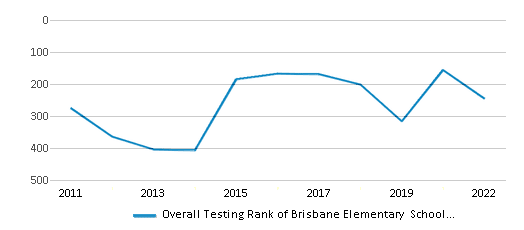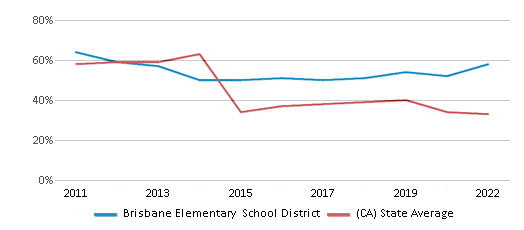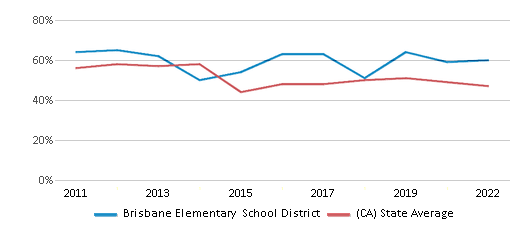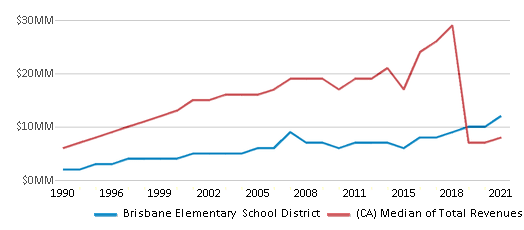Top Rankings
Brisbane Elementary School District ranks among the top 20% of public school district in California for:
Category
Attribute
Overall Rank
Highest overall rank (Top 20%)
Math Proficiency
Highest math proficiency (Top 10%)
Reading/Language Arts Proficiency
Highest reading/language arts proficiency (Top 20%)
Diversity
Most diverse schools (Top 1%)
Student Attention
Lowest student:teacher ratio (Top 1%)
For the 2025 school year, there are 3 public schools serving 477 students in Brisbane Elementary School District. This district's average testing ranking is 9/10, which is in the top 20% of public schools in California.
Public Schools in Brisbane Elementary School District have an average math proficiency score of 58% (versus the California public school average of 33%), and reading proficiency score of 60% (versus the 47% statewide average).
Minority enrollment is 79% of the student body (majority Asian), which is less than the California public school average of 80% (majority Hispanic).
Overview
This School District
This State (CA)
# Schools
3 Schools
10,369 Schools
# Students
477 Students
5,826,838 Students
# Teachers
30 Teachers
268,018 Teachers
Student : Teacher Ratio
16:1
16:1
District Rank
Brisbane Elementary School District, which is ranked #237 of all 1,925 school districts in California (based off of combined math and reading proficiency testing data) for the 2021-2022 school year.
Overall District Rank
#245 out of 1941 school districts
(Top 20%)
(Top 20%)

Math Test Scores (% Proficient)
58%
33%

Reading/Language Arts Test Scores (% Proficient)
60%
47%

Science Test Scores (% Proficient)
35-39%
29%
Students by Ethnicity:
Diversity Score
0.73
0.63
# American Indian Students
n/a
25,796 Students
% American Indian Students
n/a
1%
# Asian Students
172 Students
705,807 Students
% Asian Students
36%
12%
# Hispanic Students
139 Students
3,264,561 Students
% Hispanic Students
29%
56%
# Black Students
7 Students
286,112 Students
% Black Students
1%
5%
# White Students
98 Students
1,178,558 Students
% White Students
21%
20%
# Hawaiian Students
n/a
23,731 Students
% Hawaiian Students
n/a
n/a
# Two or more races Students
61 Students
333,755 Students
% of Two or more races Students
13%
6%
Students by Grade:
# Students in PK Grade:
-
83
# Students in K Grade:
63
522,456
# Students in 1st Grade:
57
396,605
# Students in 2nd Grade:
48
414,466
# Students in 3rd Grade:
44
416,628
# Students in 4th Grade:
51
426,361
# Students in 5th Grade:
52
430,587
# Students in 6th Grade:
63
432,997
# Students in 7th Grade:
53
439,621
# Students in 8th Grade:
46
441,777
# Students in 9th Grade:
-
466,534
# Students in 10th Grade:
-
476,585
# Students in 11th Grade:
-
469,511
# Students in 12th Grade:
-
492,627
# Ungraded Students:
-
-
District Revenue and Spending
The revenue/student of $25,994 is higher than the state median of $19,974. The school district revenue/student has stayed relatively flat over four school years.
The school district's spending/student of $23,832 is higher than the state median of $18,396. The school district spending/student has stayed relatively flat over four school years.
Total Revenue
$12 MM
$116,387 MM

Spending
$11 MM
$107,188 MM

Revenue / Student
$25,994
$19,974

Spending / Student
$23,832
$18,396

Best Brisbane Elementary School District Public Schools (2025)
School
(Math and Reading Proficiency)
(Math and Reading Proficiency)
Location
Grades
Students
Rank: #11.
Brisbane Elementary School
(Math: 65-69% | Reading: 65-69%)
Rank:
Rank:
9/
Top 20%10
500 San Bruno Ave.
Brisbane, CA 94005
(415) 467-0120
Brisbane, CA 94005
(415) 467-0120
Grades: K-5
| 187 students
Rank: #22.
Lipman Middle School
(Math: 55-59% | Reading: 65-69%)
Rank:
Rank:
9/
Top 20%10
1 Solano St.
Brisbane, CA 94005
(415) 467-9541
Brisbane, CA 94005
(415) 467-9541
Grades: 6-8
| 162 students
Rank: #33.
Panorama Elementary School
(Math: 45-49% | Reading: 35-39%)
Rank:
Rank:
6/
Top 50%10
25 Bellevue Ave.
Daly City, CA 94014
(415) 586-6595
Daly City, CA 94014
(415) 586-6595
Grades: K-5
| 128 students
Frequently Asked Questions
How many schools belong to Brisbane Elementary School District?
Brisbane Elementary School District manages 3 public schools serving 477 students.
What is the rank of Brisbane Elementary School District?
Brisbane Elementary School District is ranked #237 out of 1,925 school districts in California (top 20%) based off of combined math and reading proficiency testing data for the 2021-2022 school year. This district ranks in the top 20% of California school districts for: Highest overall rank (Top 20%), Highest math proficiency (Top 10%), Highest reading/language arts proficiency (Top 20%), Most diverse schools (Top 1%) and Lowest student:teacher ratio (Top 1%)
What is the racial composition of students in Brisbane Elementary School District?
36% of Brisbane Elementary School District students are Asian, 29% of students are Hispanic, 21% of students are White, 13% of students are Two or more races, and 1% of students are Black.
What is the student/teacher ratio of Brisbane Elementary School District?
Brisbane Elementary School District has a student/teacher ratio of 16:1, which is lower than the California state average of 22:1.
What is Brisbane Elementary School District's spending/student ratio?
The school district's spending/student of $23,832 is higher than the state median of $18,396. The school district spending/student has stayed relatively flat over four school years.
Recent Articles

Year-Round Or Traditional Schedule?
Which is more appropriate for your child? A year-round attendance schedule or traditional schedule? We look at the pros and cons.

Why You Should Encourage Your Child to Join a Sports Team
Participating in team sports has a great many benefits for children, there is no doubt. In this article you will learn what those benefits are.

White Students are Now the Minority in U.S. Public Schools
Increasing birth rates among immigrant families from Asia and Central and South America, combined with lower birth rates among white families, means that for the first time in history, public school students in the United States are majority-minority. This shift in demographics poses difficulties for schools as they work to accommodate children of varying language abilities and socio-economic backgrounds.





